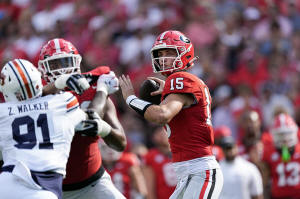NCAA's $2.78 billion settlement
with colleges to allow athlete payments gets preliminary approval
 Send a link to a friend
Send a link to a friend
 [October 08, 2024]
By EDDIE PELLS [October 08, 2024]
By EDDIE PELLS
A judge granted preliminary approval Monday to the $2.78 billion
legal settlement that would transform college sports by allowing
schools to pay players.
U.S. District Judge Claudia Wilken released an order setting a
timeline for a deal that would put millions of dollars into the
pockets of college athletes, who can begin applying for payment on
Oct. 18.
A final hearing is set for April 7, 2025, the day that one of
college sports' biggest moneymakers, March Madness, comes to a close
with college basketball's national title game. If finalized, the
deal would allow the biggest schools to establish a pool of about
$21.5 million in the first year to distribute money to athletes
through a revenue-sharing plan. Athletes would still be able to cut
name, image and likeness deals with outside groups.
Former college athletes from as far back as 2016 would be able to
apply for their share of $2.576 billion set aside to help them
recoup money they could've made from NIL deals, which weren't
allowed until 2021.
“We are pleased that we are one step closer to a revolutionary
change in college athletics that will allow billions in revenue
sharing,” said plaintiff attorney Steve Berman.
The judge’s approval comes 11 days after attorneys tweaked wording
in the original settlement agreement to address Wilken’s concerns.
The main change involved getting rid of the word “boosters” and
replacing it with a better-defined description of whose potential
NIL deals would be subject to oversight by a neutral arbitrator once
the deal goes through.
That did not, however, strike to the heart of the settlement, which
sets up a revenue-sharing arrangement between schools and athletes
who, for decades, played for scholarships, a few expenses and little
else, while coaches and athletic departments brought in millions.
The $21.5 million figure comes from the 22% of average revenue that
power conference schools generate through media rights, tickets and
other sources. It will be recalculated periodically through the
10-year window the agreement covers.
Not every school will chip in the full amount. Those that will are
hurrying to find ways to replace what they'll pay out to athletes.
They worry it could impact their overall sports programs, especially
the “non-revenue” sports that play an outsized role in populating
U.S. Olympic rosters.
“We are thrilled by Judge Wilken’s decision to give preliminary
approval to the landmark settlement that will help bring stability
and sustainability to college athletics while delivering increased
benefits to student-athletes for years to come,” said NCAA President
Charlie Baker. “Today’s progress is a significant step in writing
the next chapter for the future of college sports.”
[to top of second column] |

Georgia quarterback Carson Beck (15) throws from the pocket in the
first half of an NCAA college football game against Auburn Saturday,
Oct. 5, 2024, in Athens, Ga. (AP Photo/John Bazemore)

In addition to creating a payment system, the
settlement sets up a framework to regulate future NIL deals and
replaces scholarship caps with “roster limits,” which will grow to
105 for football, the biggest sport at most major universities, and
also the sport that brings in the most money while incurring the
most expense.
How those new roster caps and everything else will impact Title IX
has yet to be seen. Plaintiffs lawyers have estimated around 90% of
the money will go to football and men's basketball players whose
sports bring in the lion's share of the revenue. Critics of the
settlement have suggested that could be in violation of Title IX.
This settlement resolves three major antitrust lawsuits filed
against the NCAA, including one spearheaded by Grant House, a former
swimmer at Arizona State. Berman’s law firm says the value of new
payments and benefits to college athletes is expected to exceed $20
billion over 10 years.
The $21 million that the biggest schools will dole out represents
not even 10% of an NFL salary cap, but is considered big progress
for college sports, which are undergoing a revolution with an
expanded football playoff (with its $7.8 billion TV contract) and a
related move to mega-conferences; the Southeastern and Big Ten
Conferences now have 34 teams between them.
“For far too long, these athletes have been deprived of their
economic rights in an unjust system that will now, finally, be
fundamentally reformed,” plaintiff attorney Jeffrey Kessler said in
a news release that was part of the court filings.
Still unknown is how long the terms of this deal will last.
Litigation regarding the rights of players to unionize and
potentially be considered employees remains unsettled. Meanwhile,
the NCAA is pushing for federal legislation to knit together a
streamlined policy for NIL, which is currently regulated by a
patchwork of state laws, legal settlements and NCAA rules.
All contents © copyright 2024 Associated Press. All rights reserved
 |